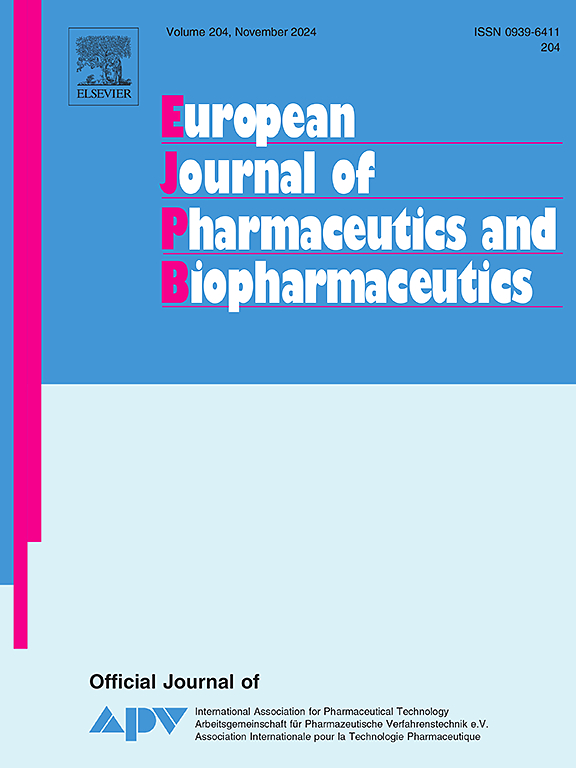姜黄素载玉米蛋白和紫胶复合纳米颗粒治疗溃疡性结肠炎。
IF 4.4
2区 医学
Q1 PHARMACOLOGY & PHARMACY
European Journal of Pharmaceutics and Biopharmaceutics
Pub Date : 2025-02-04
DOI:10.1016/j.ejpb.2025.114658
引用次数: 0
摘要
本研究强调了微流控技术在制造姜黄素(Cur)负载玉米蛋白 + 紫胶(Z + S)混合纳米颗粒(NPs)方面的功效,为提高Cur在食品工业,特别是饮料中的可用性提供了一条有前途的途径,并将其定位为一种有效的抗氧化剂策略,用于治疗肠炎等应用。研究发现,随着紫胶添加量的增加,Z + S NPs的粒径逐渐增大,PDI先减小后增大。紫胶包封后,随着紫胶用量的增加,其粒径和PDI逐渐减小,包封效率(EE)逐渐提高。当玉米蛋白与紫胶的比例保持不变时,随着Cur浓度的升高,EE逐渐降低,载药量逐渐增加。持续的低Zeta电位(低于-20 mV)证实了NPs的胶体稳定性,使其适合长期储存。NPs与正常细胞具有良好的生物相容性,并具有清除自由基的能力。紫胶与玉米蛋白的混合可调节NPs中Cur的释放谱,映射人体内的食物命运,提高溃疡性结肠炎的治疗效果。体内实验表明,NPs能够有效缓解DSS诱导的肠炎,为溃疡性结肠炎的治疗提供了一种有希望的方法。本文章由计算机程序翻译,如有差异,请以英文原文为准。

Curcumin-loaded zein and shellac composite nanoparticles for ulcerative colitis treatment
This study highlights the efficacy of microfluidic technology in creating curcumin (Cur) loaded zein + shellac (Z + S) hybrid nanoparticles (NPs), presenting a promising avenue for enhancing Cur’s availability in the food industry, especially in beverages, and positioning it as a potent antioxidant strategy for applications such as the treatment of enteritis. The study revealed that an increase in the proportion of shellac led to a gradual increase in the particle size of Z + S NPs, while the polydispersity index (PDI) initially decreasing and then increasing. When Cur is encapsulated, an increase in the proportion of shellac resulted in a gradual decrease in particle size and PDI, accompanied by an increase in encapsulation efficiency (EE). When the ratio of zein and shellac remained constant, elevating the Cur concentration led to a gradual decrease in EE and a gradual increase in drug loading. The consistently low Zeta potential (below −20 mV) confirmed the colloidal stability of the NPs, making them suitable for prolonged storage. The NPs exhibited excellent biocompatibility with normal cells and demonstrated effective free radical scavenging capabilities. Mixing of shellac and zein regulated the release profile of Cur from the NPs, mapping the food fate in human body, enhancing the treatment efficacy of ulcerative colitis. In vivo experiment demonstrated that the NPs are able to effectively relieve the dextran sulphate sodium induced enteritis, providing a promising approach for the treatment of ulcerative colitis.
求助全文
通过发布文献求助,成功后即可免费获取论文全文。
去求助
来源期刊
CiteScore
8.80
自引率
4.10%
发文量
211
审稿时长
36 days
期刊介绍:
The European Journal of Pharmaceutics and Biopharmaceutics provides a medium for the publication of novel, innovative and hypothesis-driven research from the areas of Pharmaceutics and Biopharmaceutics.
Topics covered include for example:
Design and development of drug delivery systems for pharmaceuticals and biopharmaceuticals (small molecules, proteins, nucleic acids)
Aspects of manufacturing process design
Biomedical aspects of drug product design
Strategies and formulations for controlled drug transport across biological barriers
Physicochemical aspects of drug product development
Novel excipients for drug product design
Drug delivery and controlled release systems for systemic and local applications
Nanomaterials for therapeutic and diagnostic purposes
Advanced therapy medicinal products
Medical devices supporting a distinct pharmacological effect.

 求助内容:
求助内容: 应助结果提醒方式:
应助结果提醒方式:


